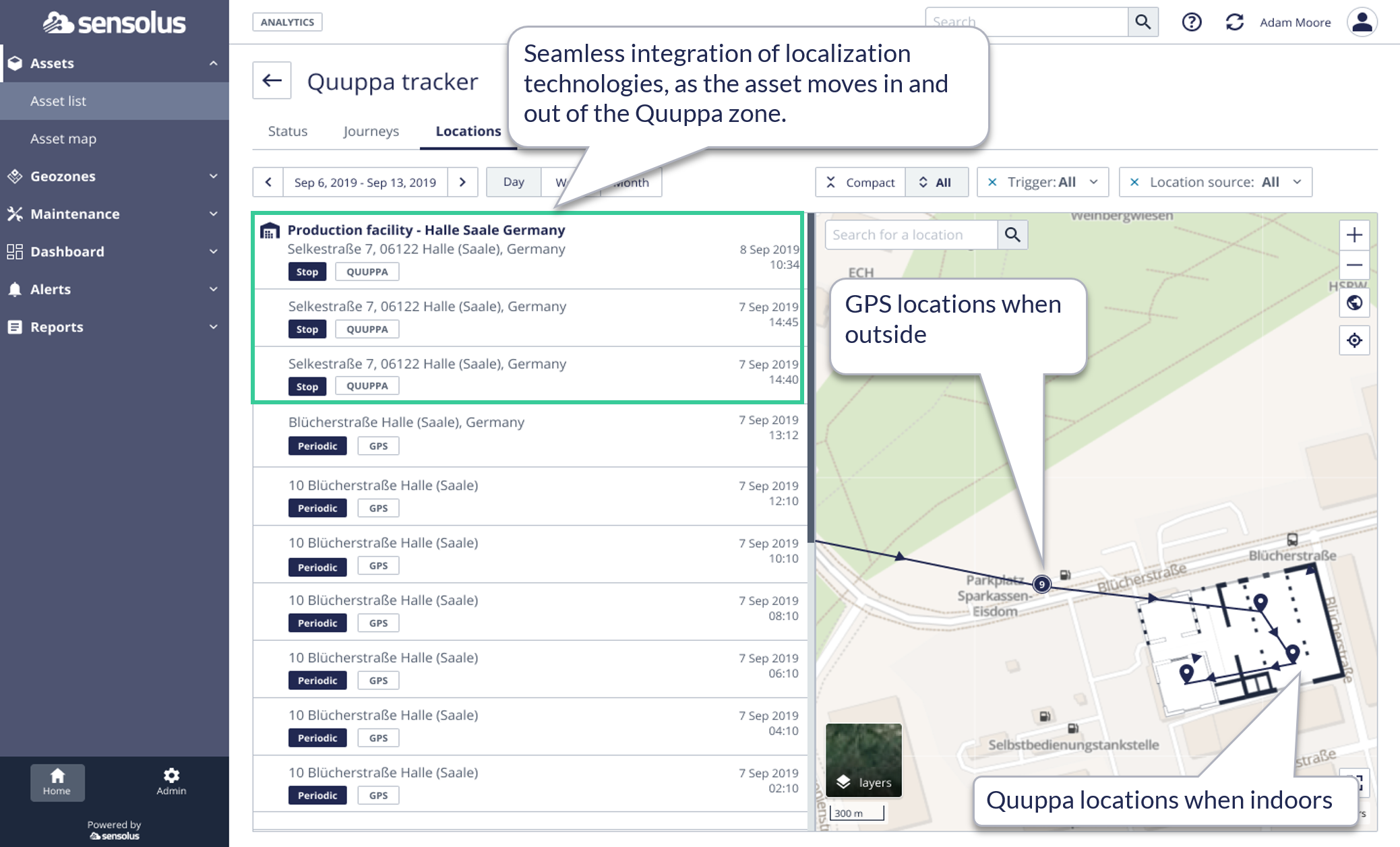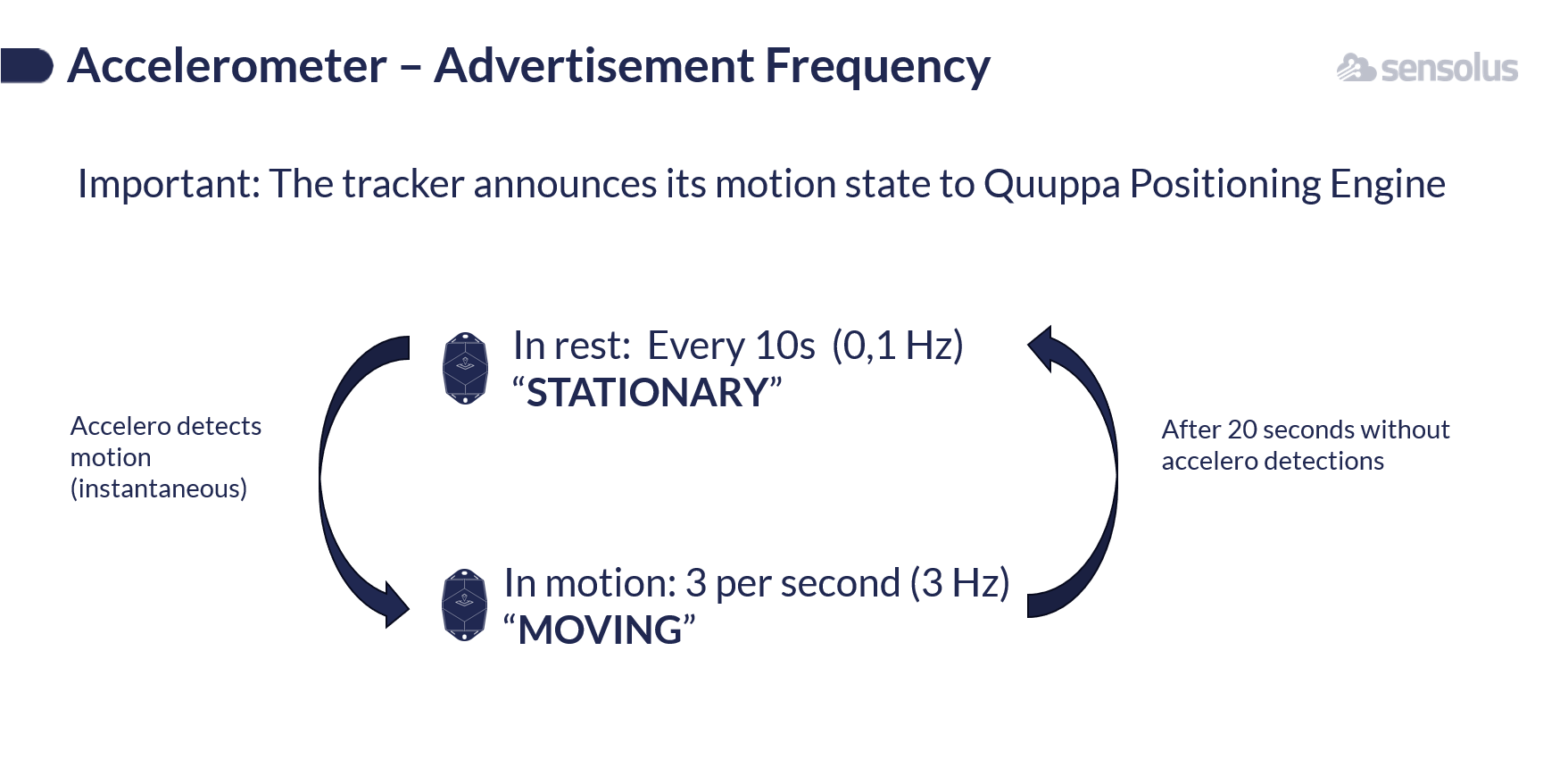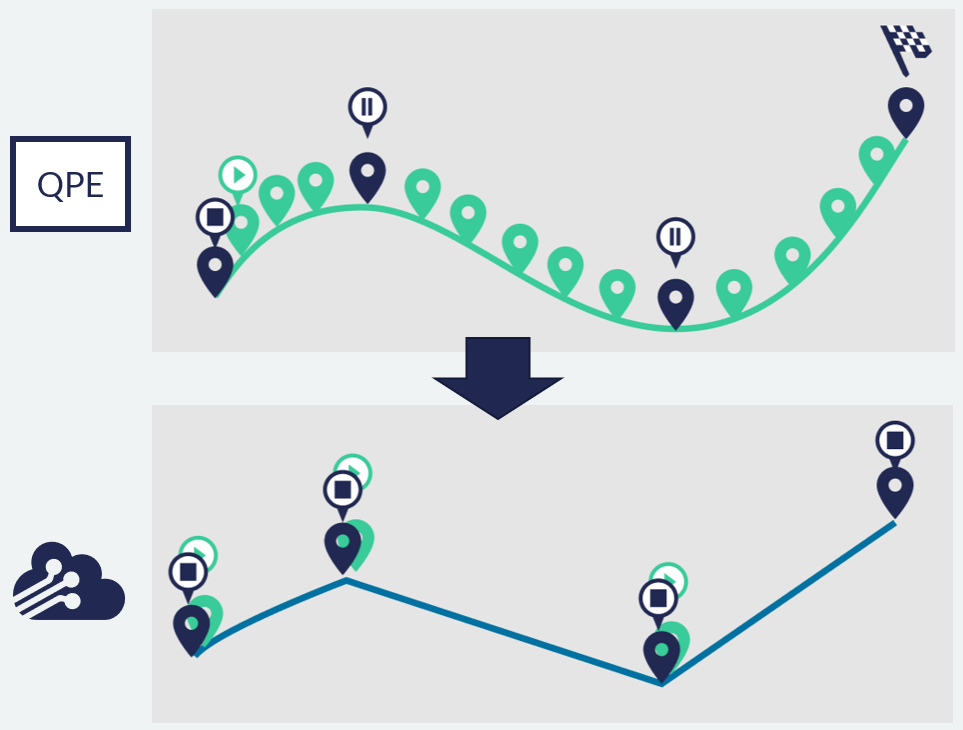Understanding asset locations with Quuppa enabled areas
More details on how and when exactly Quuppa locations are stored in the location history. Read this to understand the expected behavior of the Sensolus - Quuppa integration.
When a Quuppa-enabled battery powered tracker is being transported in and out a Quuppa zone, the expected behavior is that a single, seamless location history is visible in the platform. This location history then drives the other platform features, such as the journey view, geozone visits, and more. Ultimately, to the platform, a Quuppa location point is almost identical to a GPS location point - only the accuracy and technology differ.

There are, however, some important details to how this works exactly - these are explained on this page.
Understanding the motion state with Quuppa
To understand the behavior of the integrated solution, you must understand the motion state. The Quuppa Positioning Engine continuously evaluates whether a tag (tracker) is either stationary or moving. As explained further on this page, this ultimately determines how many location points are stored in the Sensolus platform.

With the Sensolus trackers, the motion state in QPE is directly derived from the tracker advertisements via BLE, based on the tracker's internal accelerometer:
- Stationary: Means the tracker has not moved during at least the last 20 seconds.
- Moving: On any motion (vibration) the tracker immediately will announce the moving state.
Time and distance between location points
A Quuppa system provides location data at very fast rates (for example every second per tag, or even faster). Filtering (sub-sampling) takes place at the level of the Sensolus-Quuppa-Bridge.
The goal of the integrated solution is to store only the locations of key importance in the Sensolus platform. This means essentially that the locations where the asset is stopped are stored; as well as the timestamps when the assets start moving. The solution does not store the detail itinerary during motion.

A new location point will be inserted in the Sensolus platform:.
- On stop (stationary): When the asset was moving, and becomes stationary.
- On start of motion (moving): when the asset was stationary before, and starts moving. Only the first location point and timestamp are stored in the platform, because it is valuable to know the start time this movement (this ultimately enables deriving the journey duration and utilization calculation).
- When exiting the Quuppa zone: When the asset is no longer detected by QPE (see below for details on the locationType), then an EXIT event location stored. This indicates that the asset is no longer present, and is especially useful when no other subsequent localization (for example a GPS fix) has occurred yet.
- Positioning changes while stationary:A common QPE behavior is that, immediately after asset movement has finished, the QPE position still changes, even while it is already in the stationary state. To avoid that each such small position updates would cause excessive location points to be stored in the platform, the SQB will ignore small movements while stationary. However, when the asset is continuously stationary but QPE transmits a new position sufficiently far away from the previous position (configurable distance threshold, for example 1 meter), a new location will be inserted anyway. This explains why you can see subsequent stop events without any motion.
- Periodic events:By default, every hour a periodic location point will be inserted, confirming the presence of the tracker in the Quuppa high-precision zone.
Trackers are unaware of the Quuppa area
The Quuppa-enabled tracker is visible to the Quuppa system. However, the tracker is completely unaware that it is in a Quuppa zone. This means, the tracker will keep performing the regular localization attempts (such as GPS, Wi-Fi, Geobeacon or Network localization) as if it were outside or in any other indoor building. So, these location messages are sent over the NB-IoT network to the Sensolus platform. The Sensolus platform will discard any tracker-generated location points whenever the tracker was in a Quuppa zone, at this timestamp.
In other words, while in Quuppa area, only quuppa location points are stored, because they have the highest accuracy and shortest latency. The platform takes care that less accurate locations do not pollute the location history of the asset with less accurate locations independently generated by the tracker .
More information on locationMovementStatus: https://www.quuppa.com/documentation/QPE/topics/QPE_tag_tree.html#QPE_tag_tree__section_p2r_jjq_z4b
Impact of the Quuppa locationType
QPE announces the level of confidence in each location message sent to the Sensolus-Quuppa-Bridge (SQB). The SQB uses this to retain only relevant locations. The less accurate locationTypes are ignored. The following table describes how QPE locationTypes are interpreted:
| locationType | QPE meaning | Sensolus interpretation |
|---|---|---|
| position | The most accurate type of location, highest confidence. | Used to create location records. |
| approximate | The location is a bit less accurate, indicated by the accuracy radius | Used to create location records. |
| proximity | No reliable detection is possible; the location property are the coordinates of the nearest locator. | No location records are created for this locationType. But, these data updates are used to confirm presence of the asset in the Quuppa zone. |
| presence | The system can place the tag in a coordinate system, but cannot determine it's location or the location of a nearby Locator. In such cases, the location property is set to null. | No location records are created for these locationTypes. Additionally, when an asset was just before in the position or approximate state, and then remains in any of these inaccurate state, it will be considered as having left the Quuppa zone (default after 3 minutes): an EXIT event location is inserted in the location history. |
| hidden | When a tag is in a zone that has been set to hide location information. | |
| noLocation | When the tag has been heard by the system but the system has been unable to determine a location for the tag. | |
| noData | When the tag has been added to the system but has not been picked up by the Locators. |
More information on the location types in Quuppa: https://www.quuppa.com/documentation/QPE/topics/QPE_tag_tree.html#QPE_tag_tree__section_p2r_jjq_z4b
Practically, this means that sufficient accuracy must be obtained (sufficient and properly configured Quuppa Locators) to cause location updates in the Sensolus platform.
- Position or approximate locationTypes are required to add new location points in the Sensolus platform.
- Proximity locationTypes only are used to keep confirming presence in the Quuppa zone. Even in well functioning deployments, Proximity locationTypes will occur when the asset is standing still (and the BLE announcement rate falls back to 0.1 Hz). When the asset starts moving, the locationType will typically improve to Position or Approximate due to the faster BLE announcement rate.
- Recommended: It may be useful to create zones in the Quuppa Site Planner, that causing hiding location data in QPE, in the areas immediately surrounding the zone where high-precision tracking is needed. This will cause more precise recording of the EXIT events in the location history.